Hustopeče
Hustopeče (Czech pronunciation: [ˈɦustopɛtʃɛ]; German: Auspitz) is a town in Břeclav District in the South Moravian Region of the Czech Republic. It has about 6,200 inhabitants. It is known for fruit and wine growing.
Hustopeče | |
|---|---|
 Main square with town hall | |
 Flag  Coat of arms | |
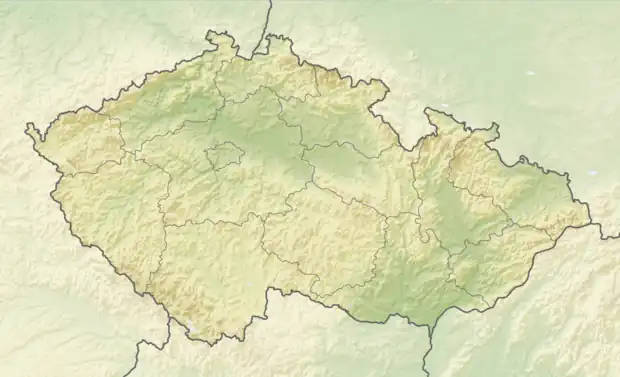 Hustopeče Location in the Czech Republic | |
| Coordinates: 48°56′27″N 16°44′15″E | |
| Country | |
| Region | South Moravian |
| District | Břeclav |
| First mentioned | 1247 |
| Government | |
| • Mayor | Hana Potměšilová |
| Area | |
| • Total | 24.53 km2 (9.47 sq mi) |
| Elevation | 215 m (705 ft) |
| Population (2023-01-01)[1] | |
| • Total | 6,248 |
| • Density | 250/km2 (660/sq mi) |
| Time zone | UTC+1 (CET) |
| • Summer (DST) | UTC+2 (CEST) |
| Postal code | 693 01 |
| Website | www |
Etymology
The name of the town is derived from the name of the nobleman and alleged founder of Hustopeče, named Úsopek.[2]
Geography
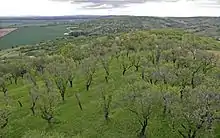
Hustopeče is located about 25 kilometres (16 mi) northwest of Břeclav and 28 km (17 mi) south of Brno. The northern part of the municipal territory lies within the southern foothills of the Ždánice Forest range and the southern part lies in the Lower Morava Valley lowland. The town lies in the warmest part of the country.
History

The first written mention of Hustopeče is from 1247. In the 13th century, the area was settled by German colonizators, who brought viticulture here. The German name of Hustopeče Auspitz was first documented in 1279.[3]
From the beginning of the 14th century until 1599, Hustopeče was owned by the Cistercian abbey in Brno. The advantageous location on the border of three countries made Hustopeče an important economic centre with markets. In 1572, Emperor Maximilian II promoted Hustopeče to a town. From 1599 to 1848, Hustopeče was property of the House of Liechtenstein.[3]
In 1531, Anabaptists led by Jakob Hutter came into the town from Tyrol and Carinthia, and founded a Hutterite community. Hustopeče became the centre of Moravian Anabaptists.[4]
Hustopeče was badly damaged during the Thirty Years' War During this period, the acreage of vineyards fell to 10% of its original state. However, winemaking gradually recovered, and in the mid-18th century, Hustopeče was the largest wine-growing municipality in Moravia. In 1726, the winemaking guild was established.[2]
In 1756, the Piarists established a first gymnasium here. On 18 July 1894, Hustopeče received access to a Lokalbahn branch line to Šakvice and the Emperor Ferdinand Northern Railway from Vienna to Prague. Until 1918, Auspitz – Hustopeče was part of the Austrian monarchy (Austrian side after the Compromise of 1867), in the district with the same name, one of the 34 Bezirkshauptmannschaften in the Cisleithanian Margraviate of Moravia.[5] According to the 1910 census, most of its inhabitants were ethnic Germans.
After World War I and the dissolution of Austria-Hungary, large parts of the South Moravian region were claimed by the newly established Republic of German-Austria; nevertheless, according to the 1919 Treaty of Saint-Germain, Hustopeče and it surroundings passed the First Czechoslovak Republic. After the Munich Agreement in 1938, it was occupied by Nazi Germany and incorporated into Reichsgau Niederdonau as one of the municipalities in Sudetenland. After World War II, Hustopeče returned to Czechoslovakia and the remaining German-speaking population was expelled according to the Beneš decrees.[6]
Demographics
|
|
| ||||||||||||||||||||||||||||||||||||||||||||||||||||||
| Source: Censuses[7][8] | ||||||||||||||||||||||||||||||||||||||||||||||||||||||||
Economy
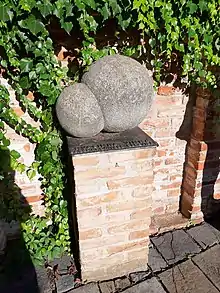
Hustopeče is known for viticulture and also for almond growing, which is unique in Central Europe.[9]
Transport
The D2 motorway from Brno to the border with Slovakia runs through the town.
Sport
Each year, Hustopeče is host to the world's best high jumpers competing in the Moravia High Jump Tour.[10]
Sights

The main landmark is the Gothic parish Church of Saints Wenceslaus and Agnes of Bohemia. The original Church of St. Wenceslaus was built in the early 14th century. Though renovated several times, its steeple collapsed in 1961 and damaged the church's structure greatly. Despite efforts to preserve the valuable remaining part, it was decided to demolish the entire building. The new modern church was built on the site of the old one in 1994 and consecrated to Saints Wenceslaus and Agnes of Bohemia. The new church has a 52-metre (171 ft) high steeple.[11]
The second landmark of the town square is the town hall. This Neo-Renaissance building comes from 1906.[12]
Notable people
- Tomáš Garrigue Masaryk (1850–1937), politician, the first president of Czechoslovakia; lived here in 1861–1868
- Josef Šural (1990–2019), footballer
- Michal Sáček (born 1996), footballer
Twin towns – sister cities
Hustopeče is twinned with:[13][14]
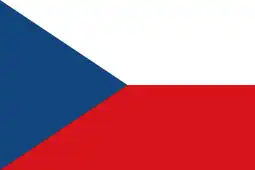 Benátky nad Jizerou, Czech Republic
Benátky nad Jizerou, Czech Republic Miedźna, Poland
Miedźna, Poland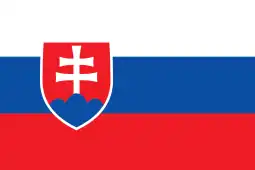 Modra, Slovakia
Modra, Slovakia
References
- "Population of Municipalities – 1 January 2023". Czech Statistical Office. 2023-05-23.
- "Hustopeče – středověká bašta moravského vinařství". Moravské vinařské stezky (in Czech). Retrieved 2022-08-14.
- "O historii města" (in Czech). Město Hustopeče. Retrieved 2021-11-26.
- "Setkání Habánů v Hustopečích" (in Czech). CzechTourism. Retrieved 2022-08-14.
- Die postalischen Abstempelungen auf den österreichischen Postwertzeichen-Ausgaben 1867, 1883 und 1890, Wilhelm Klein, 1967
- Spěvák, Přemysl (2013-09-16). "Návrat krásy. Společenský dům ladí Hustopečští do historie". Břeclavský Deník (in Czech). Deník.cz. Retrieved 2022-08-14.
- "Historický lexikon obcí České republiky 1869–2011 – Okres Břeclav" (in Czech). Czech Statistical Office. 2015-12-21. pp. 1–2.
- "Population Census 2021: Population by sex". Public Database. Czech Statistical Office. 2021-03-27.
- "Město Hustopeče" (in Czech). Město Hustopeče. Retrieved 2021-11-26.
- "Home". Hustopečské skákání. Retrieved 2022-08-14.
- "Kostel sv. Václava v Hustopečích" (in Czech). CzechTourism. Retrieved 2021-11-26.
- "Radnice" (in Czech). Město Hustopeče. Retrieved 2021-11-26.
- "Hustopeče dál rozvíjí spolupráci s partnerskými městy" (in Czech). Město Hustopeče. 2019-03-05. Retrieved 2020-09-29.
- "Miasta partnerskie" (in Polish). Gmina Miedźna. 26 October 2015. Retrieved 2020-09-29.